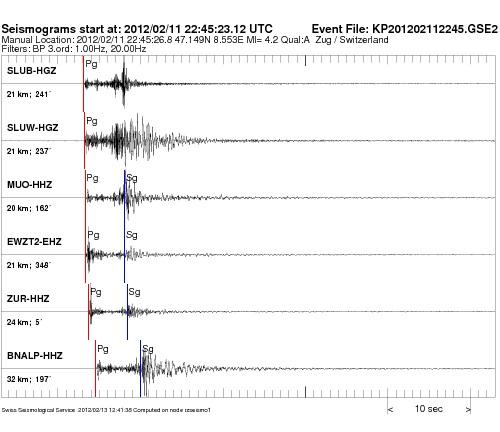Earthquake near Zug, February 11 2012
The magnitude 4.2 earthquake that occurred on February 11 at 11.45pm local time (10.45pm UTC) between Zuger- and Ägerisee, was the strongest earthquake to occur in Switzerland since the September 2005 magnitude 4.9 earthquake in Vallorcine (near Martigny). Similarly strong earthquakes to the near-Zug event were last recorded in January 2009 (near Wildhaus, Toggenburg) and in May 2009 (near Steinen, Südschwarzwald, Germany). On a long-term average, there are one or two events of magnitude 4 in Switzerland per year, but there have been fewer than average in the last couple of years.
Cause
The hypocenter (the earthquake’s origin within the Earth) lies at an approximate depth of 30 km, slightly above the “Moho“, which marks the transition between the Earth’s crust and the mantle. Like most seismic activity in Switzerland, this earthquake is an expression of the tectonic stresses across the Alpine region. These stresses result from the collision between the European and the African continental plates, which has led to the formation of the Alps.
Perception
The earthquake was clearly felt all over the German-speaking parts of Switzerland, as well as in the Wallis and the Tessin. As would be expected, the perceived shaking was strongest near the epicenter (the point on the Earth’s surface directly above the hypocenter). On the European Macroseismic Scale (EMS), which quantifies the impact of a earthquake at the surface, the event was classified between IV and V. Earthquakes of this size can cause minor sporadic damage to premises or buildings (e.g. plaster cracks), but because the event was unusually deep, such damage is in fact rather unlikely from a seismological perspective. In the 2500 questionnaires submitted to the SED to date, 40 contained reports on hair-like fissures. However, there are media reports documenting cracks in walls. Whether these cracks were actually caused by the earthquake, would require some more detailed investigation. Such tremors can also widen existing cracks that prior to the earthquake were covered with plaster or paint and thus became more visible.
Earthquake related noise
Many people reported a loud “bang”, similar to an explosion, at the beginning of or even slightly before the ground shaking. Many people reported a loud “bang”, similar to an explosion, at the beginning of or even slightly before the ground shaking. The latter stages of the tremor were frequently associated with a rumbling noise that was sometimes described as a second bang. Such sounds, a common feature of earthquakes, are produced when seismic waves hit the Earth’s surface and induce sonic waves. “Bang”-like sounds can be produced from higher frequency seismic waves. These reported sounds are in good agreement with the observation that the earthquake (or more precisely the start of the tremor) was often felt like a jolt. The generation of such noise depends on local conditions and can vary strongly even over short distances.
Two earthquake motions
Another commonly reported observation was that there was a second separate shock immediately following the first shock. Though there was only one earthquake, this observation is explained by the recorded seismograms from the Swiss seismic network, which at many stations show to two distinct segments with large amplitudes. These two segments correspond to the arrival of P- and S-waves at the stations, both of which originate from the same earthquake. Surface waves that are often perceived as „rolling“ motions and are often felt in similar sized earthquakes have been barely observed from this event due to the large hypocenter depth.
Aftershocks
In general, earthquakes of this size often produce aftershocks. However, it is also a common observation that earthquakes that happen at such depths do not produce any aftershocks. Whether there will be aftershocks in the coming days is not predictable.
One small aftershock of magnitude 1.1 occurred on February 14 at 19:15. The aftershock wasn't strong enough to be felt. Until Wednesday afternoon no further aftershocks have been recorded.
Earthquakes in Switzerland
Last Saturday’s earthquake was not strong enough to cause serious damage. On an global scale, the earthquake hazard in Switzerland is on an intermediate level. Large earthquakes producing severe damage occur here much less frequently than in places like Greece or Italy. However, in Switzerland there is on average one magnitude 6 event in 100 years. Such an event can cause severe damage to buildings that were not built according to modern earthquake safety standards. The 1356 Basel earthquake had a magnitude between 6.5 and 7 and was the largest historical earthquake in Europe north of the Alps. The recurrence period of such an event is difficult to assess, but recent studies suggest it may re-occur between every 1500 and 2000 years.
The best protection against earthquake hazard can be achieved by following earthquake-proof building design, coupled with the knowledge on how to act appropriately in the case of an event.
